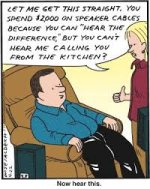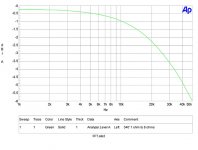True .... but that´s what Zobel Networks are for (among other things).Get out your antenna physics handbook. As Cordell writes "EMI Ingress: Antennas Everywhere" When you get into the MHz the cable, even connected to a loudspeaker, acts as a badly terminated radiator.
The amplifier, which is what worries us being an active device, will always see, say, 10 ohms, and quite resistive at that.
IF necessary, a similar Zobel might be wired across cabinet input terminals ... a $ 2 solution and better than a $2400 exotic cable.
In any case, if it were necessary to Zobel cabinets, many would do so; that almost nobody does might indicate something.
A few crossovers do though, more power to their designers, and no, I don´t consider that snake oil at all, in this case it means attention to detail.
Without the profits made from selling cables, there would probably be even fewer Hi-Fi emporiums in existence.And there are tons of "snake oil" salesmen on the internet and even in stores - they need your money.
So I wouldn't knock expensive cables completely. Their purchase allows those with the deepest pockets to make a difference for the rest of us.
Attachments
True .... but that´s what Zobel Networks are for (among other things).
In any case, if it were necessary to Zobel cabinets, many would do so; that almost nobody does might indicate something.
Expensive amplifiers behaving badly!
I did one of those "lumped parameter" simulations of the cable in question and the sim looks very much like the graph.
a 5R 220nF Zobel on the terminating end seemed to quiet things down quite a bit, but I think that what Bob Cordell is getting at is the radiation captured by a badly terminated transmission line possibly exciting the amplifier under test.
Maybe we're just counting angels on the head of a pin, more a problem in theory than praxis.
@galu -- the cartoon describes my marital situation exactly although I almost universally use Radio Shack flat cable.
Last edited:
My wife's opposition to speaker cables ceased when I installed white, flat speaker cable.@galu -- the cartoon describes my marital situation exactly although I almost universally use Radio Shack flat cable.
She likes the way the flat cable dresses neatly as it descends from our stand mounts, and also the way that it almost disappears between the skirting board and the carpet.
As they say: "happy wife, happy life!"
The system consists of essentially a simple circuit loop. You want to minimise the resistance by using thick enough conductors, and minimise the inductance by keeping the out and return conductors near each other.
There are difficult bits in audio. Speaker wire is not one of them.
Wrong. With the added resistance of the wire you change the Q of the system and influence damping.
I said minimise resistance. This is because most speakers are designed for a voltage source. However, a little resistance does little harm. "Little" means small compared with the speaker nominal impedance. If you have added enough resistance to noticeably change the bass Q then your cable is too long or too thin.schiirrn said:Wrong. With the added resistance of the wire you change the Q of the system and influence damping.
If you have added enough resistance to noticeably change the bass Q then your cable is too long or too thin.
Or the speakers have good mechanical damping and are best if driven by a higher output impedance amplifier/wire.
dave
In any case, good speaker designers must consider their cabinets being driven from a Voltage source (your average amplifier out there) plus, say, 0.1 or 0.2 ohms (cable and terminal resistance) in series.
And should not be rendered unusable by, say, 0.5 ohm
Which I bet they do, simply being realistic and designing stuff to be actually *used* in, say, a Living Room or equivalent.
Stuff which only works in a Lab environment but has problems anywhere else does not have much future.
And should not be rendered unusable by, say, 0.5 ohm
Which I bet they do, simply being realistic and designing stuff to be actually *used* in, say, a Living Room or equivalent.
Stuff which only works in a Lab environment but has problems anywhere else does not have much future.
I said minimise resistance. This is because most speakers are designed for a voltage source. However, a little resistance does little harm. "Little" means small compared with the speaker nominal impedance. If you have added enough resistance to noticeably change the bass Q then your cable is too long or too thin.
I got that you wrote "minimise". I on the other hand didn't write "bass Q" and didn't mean it.
What if someone wants to change the Q and chooses to do so with a lower gauge wire?
In any case, good speaker designers must consider their cabinets being driven from a Voltage source (your average amplifier out there) plus, say, 0.1 or 0.2 ohms (cable and terminal resistance) in series.
And should not be rendered unusable by, say, 0.5 ohm
Which I bet they do, simply being realistic and designing stuff to be actually *used* in, say, a Living Room or equivalent.
Stuff which only works in a Lab environment but has problems anywhere else does not have much future.
Is this DIYaudio or an online workshop for engineers designing audio gear for Wal Mart?
Last edited:
Is there another speaker Q affected by source resistance? The woofer LF responance is the only mechanical resonance with good coupling to the electrical domain.schiirrn said:I on the other hand didn't write "bass Q" and didn't mean it.
They are free to do so in their own music room. However, in most cases the speaker will be designed for a low source impedance and if a higher impedance is needed then the simplest option is to add a resistor in series. Using cables as tone controls seems daft to me!What if someone wants to change the Q and chooses to do so with a lower gauge wire?
Yes twisted pairs. Speaker cables can act as RF interference antennas. The interference sneaks in thru the feedback network to the input stage. It's something that Jim Brown sometimes writes about.
Speaker cable is a terrible antenae and the amp is a large RF load. Any RF that gets past that is usually bypassed before the input stage. Dont care if people write about it, why dont they test it. it would be very easy to test by injecting some RF into a speaker cable and measuring the input. Show me the numbers, not the BS.
I think we are all just looking for the best example of a component without getting robbed. Why will one person pay $80 for a Black Gate when a $5 Nichicon or Elna will do? Don't know.
About those inductor coils, and I'm no electronics wiz, but I don't see a wire coiled up to perform as a component and does a specific job as just a wire. It has different properties than a straight wire. Then again, what do I know?
On the other hand, I've used 30ga Kynar wire wrap wire as speak wire to good effect. Depends on where it's used.
Saw a guy on Youtube this morning make some nice speaker wire from Mogami speaker cables. I don't see these are particularly expensive and Mogami arguably makes good wire.
Mogami W3104 Superflexible High Definition 4 x 12 AWG Speaker Cable 1 ft.
Mogami W3103 Superflexible High Definition 2 x 12 AWG Speaker Cable 1 ft.
About those inductor coils, and I'm no electronics wiz, but I don't see a wire coiled up to perform as a component and does a specific job as just a wire. It has different properties than a straight wire. Then again, what do I know?
On the other hand, I've used 30ga Kynar wire wrap wire as speak wire to good effect. Depends on where it's used.
Saw a guy on Youtube this morning make some nice speaker wire from Mogami speaker cables. I don't see these are particularly expensive and Mogami arguably makes good wire.
Mogami W3104 Superflexible High Definition 4 x 12 AWG Speaker Cable 1 ft.
Mogami W3103 Superflexible High Definition 2 x 12 AWG Speaker Cable 1 ft.
They are free to do so in their own music room. However, in most cases the speaker will be designed for a low source impedance and if a higher impedance is needed then the simplest option is to add a resistor in series. Using cables as tone controls seems daft to me!
So it makes more sense to use low resistance wire and an additional resistor than just using cheaper wire that comes up with the same resistance as thicker wire plus resistor?
How is one of these variants a "tone control"?
A tone controls works in the electrical part. series resistances works with the damping of the mechanical parts. You cannot modify too much mechanical components, so the action is defined by the speaker and its cabinet. You can change the action of the tone control in multiple ways.
Of course cable has an effect. The only question is how much for a given situation. Attached is a frequency response plot of 100 M of lower than normal inductance loudspeaker cable driving an 8 ohm resistor.
So not surprisingly particular details matter. Now most folks here will never run 100 M of cable. But changes at 20,000 hertz start to be measured at 10 M of cable.
As to RF pickup, this starts to be a big issue with cables approaching 50 M.
So not surprisingly particular details matter. Now most folks here will never run 100 M of cable. But changes at 20,000 hertz start to be measured at 10 M of cable.
As to RF pickup, this starts to be a big issue with cables approaching 50 M.
Attachments
Last edited:
Of course cable has an effect. The only question is how much for a given situation. Attached is a frequency response plot of 100 M of lower than normal inductance loudspeaker cable driving an 8 ohm resistor.
So not surprisingly particular details matter. Now most folks here will never run 100 M of cable. But changes at 20,000 hertz start to be measured at 10 M of cable.
As to RF pickup, this starts to be a big issue with cables approaching 50 M.
All that is good information, and I'm assuming you're speaking of Meters of wire (M).
I don't know of anyone wanting to use 300 feet of wire to connect speakers of course, so it's a moot point.
In the average living/entertainment room of a residence I'd imagine wire lengths of maybe 20 feet or so - nothing to fuss over with 16 gauge zip cord wire.
- Home
- Design & Build
- Parts
- Speaker wire

